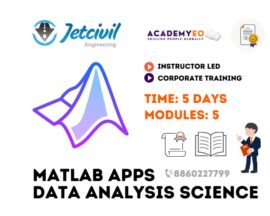R Programming Course
₹ 7,999.00
- 14 Days (1 hr/day) Course
- Indian Instructor Led
- Language: Hindi/English
- Notes & e-PDFs
- Mini Project
- Hard copy Certificate
![]()
- Description
- Additional information
Description
Course Outline: Learn R Programming Course Online via Instructor Led Program. In this course you can learn to use R for effective data analysis. You can learn how to install and configure software for a statistical programming, data analysis, environment and describe generic programming language concepts as they are implemented in a high-level statistical language. The course covers practical issues in statistical computing which includes programming in R, reading data into R, accessing R packages, writing R functions, debugging, profiling R code, and organizing and commenting R code. Topics in statistical data analysis will provide working examples.(Note: We care for your schedule and so in this course a trainer will be assigned to the student enrolled and course will start as per student convenient date and timing).
R is a programming language and free software environment for statistical computing and graphics supported by the R Foundation for Statistical Computing. The R language is widely used among statisticians and data miners for developing statistical software and data analysis. Polls, data mining surveys, and studies of scholarly literature databases show substantial increases in popularity as of July 2020, R ranks 8th in the TIOBE index, a measure of popularity of programming languages. A GNU package, the official R software environment is written primarily in C, Fortran, and R itself (thus, it is partially self-hosting) and is freely available under the GNU General Public License. Pre-compiled executables are provided for various operating systems. Although R has a command line interface, there are several third-party graphical user interfaces, such as RStudio, an integrated development environment, and Jupyter, a notebook interface.
R and its libraries implement a wide variety of statistical and graphical techniques, including linear and nonlinear modeling, classical statistical tests, time-series analysis, classification, clustering, and others. R is easily extensible through functions and extensions, and the R community is noted for its active contributions in terms of packages. Many of R’s standard functions are written in R itself, which makes it easy for users to follow the algorithmic choices made. For computationally intensive tasks, C, C++, and Fortran code can be linked and called at run time. Advanced users can write C, C++, Java, .NET or Python code to manipulate R objects directly. R is highly extensible through the use of user-submitted packages for specific functions or specific areas of study. Due to its S heritage, R has stronger object-oriented programming facilities than most statistical computing languages. Extending R is also eased by its lexical scoping rules.
Another strength of R is static graphics, which can produce publication-quality graphs, including mathematical symbols. Dynamic and interactive graphics are available through additional packages. R has Rd, its own LaTeX-like documentation format, which is used to supply comprehensive documentation, both online in a number of formats and in hard copy.
Above Text Source: Wikipedia
Additional information
| Enrollment for | Individual, Institutional |
|---|









